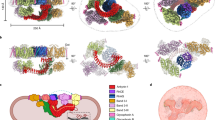Summary
A method has been developed for the assessment of the number of spectrin dimer units associated with each actin protofilament junction, in the membrane cytoskeletal network (i.e. the degree of branching) of the red cell. Ghosts are first exposed to elevated temperature at low ionic strength to dissociate some 65% of the spectrin tetramers (that link the network junctions) into dimers, without causing their release from the actin filaments. Non-ionic detergent is then added to solubilize the membrane itself with its intrinsic proteins, so as to liberate the cytoskeletal material, and the mixture is immediately examined in the analytical ultracentrifuge. The predominent components observed are isolated junctions (20 S), free spectrin dimers and the residual undissociated cytoskeletal material, with very minor components, probably corresponding to mutiple junctions, linked by spectrin tetramers. The junction boundary is homogeneous within the accuracy of measurement and is taken to correspond to a complex containing six spectrin dimers, known to predominate in situ. About 17% of the total network is liberated in this form and 12% as free spectrin dimers. In hereditary spherocytosis both the size of the junction complex (as reflected by its sedimentation coefficient) and the proportion of the complex and of free spectrin liberated are indistinguishable from normal values. We conclude that the reported deficit of spectrin in hereditary spherocytosis is not reflected by a lower degree of branching of the network, and, if the membrane area is not correspondingly reduced, this must mean that the junctions are more widely spaced and the spectrin tetramers therefore more extended. In metabolically depleted cells, in which the cytoskeletal proteins are known to be extensively dephosphorylated, there is no change in the sedimentation pattern and thus no detectable loss of spectrin from the junctions or weakening in the cohesion of the cytoskeletal network.
Similar content being viewed by others
References
Agre P, Casella JF, Zinkham WH, McMillan C, Bennett V (1985) Partial deficiency of erythrocyte spectrin in hereditary spherocytosis. Nature 314: 380–383
Bachman L (1986) Shape control in the human red cell. J Cell Sci 80: 281–298
Beaven GH, Jean-Baptiste L, Ungewickell E, Baines AJ, Shahbakhti F, Pinder JC, Lux SE, Gratzer WB (1985) An examination of the soluble oligomeric complexes extracted from the red cell membrane and their relation to the membrane cytoskeleton. Eur J Cell Biol 36: 299–306
Bennett V (1985) The membrane skeleton of human erythrocytes and its implications for more complex cells. Ann Rev Biochem 54: 273–304
Bessis M (1973) Red cell shapes, An illustrated classification and its rationale. In: Bessis M, Weed RI, Leblond PF (eds) Red cell shape. Springer Verlag, New York Berlin Heidelberg, pp 1–25
Corrers I, Leto TL, Speicher DW, Marchesi VT (1986) Identification of the functional site of erythrocyte protein 4.1 involved in spectrin-actin associations. J Biol Chem 261: 3310–3315
Dodge JT, Mitchell C, Hanahan DJ (1963) The preparation and chemical characteristics of hemoglobin-free ghosts of human erythrocytes. Arch Biochem Biophys 100: 119–130
Eder PS, Soong C-J, Tao M (1986) Phosphorylation reduces the affinity of protein 4.1 for spectrin. Biochemistry 25: 1764–1770
Evens JPM, Baines AJ, Hann IM, Al-Hakin I, Knowles SM, Hoffbrand A (1983) Defective spectrin dimer-dimer association in a family with transfusion dependent homozygous hereditary elliptocytosis. Br J Haematol 54: 163–172
Gratzer WB (1984) More red than dead. Nature 310: 368–369
Liu S-C, Derick LH, Palek J (1987) Visualization of the hexagonal lattice in the erythrocyte membrane skeleton. J Cell Biol 104: 519–526
Liu S-C, Palek J (1980) Spectrin tetramer-dimer equilidrium and the stability of erythrocyte membrane skeletons. Nature 285: 586–588
Lux SE, John KM, Ukene TE (1978) Diminished spectrin extraction from ATP-depleted human erythrocytes; Evidence relating to changes in erythrocyte shape and deformation. J Clin Invest 61: 815–827
Matsuzaki F, Sutch K, Ikai A (1985) Structural unit of the erythrocyte cytoskeleton. Isolation and electron microscopic examination. Eur J Cell Biol 39: 153–160
Palek J, Lux SE (1983) Red cell membrane skeletal defects in hereditary and acquired hemolytic anemia. Semin Hematol 20: 187–224
Schachman HK (1965) The ultracentrifuge. Academic Press, New York
Shahbakhti F, Gratzer WB (1986) Analysis of the self-association of human red cell spectrin. Biochemistry 25: 5969–5975
Ungewickell E, Gratzer WB (1978) Self-association of human spectrin: A thermodynamic and kinetic study. Eur J Biochem 88: 379–385
Author information
Authors and Affiliations
Rights and permissions
About this article
Cite this article
Morris, S.A., Kaufman, M. Ultracentrifugal analysis of the junction complexes of the red cell membrane cytoskeletal network: application to hereditary spherocytosis and metabolically depleted cells. Blut 59, 385–389 (1989). https://doi.org/10.1007/BF00321209
Received:
Accepted:
Issue Date:
DOI: https://doi.org/10.1007/BF00321209




